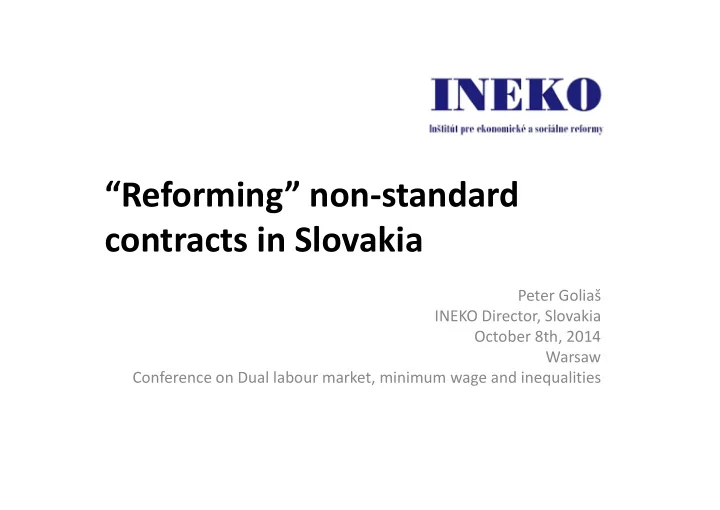

“Reforming” non-standard contracts in Slovakia Peter Goliaš INEKO Director, Slovakia October 8th, 2014 Warsaw Conference on Dual labour market, minimum wage and inequalities
Non-standard contracts • As opposed to standard employment contract: 1. Agreement to work (40% of all agreements) • Up to 10 hours per week, maximum 1 year 2. Agreement to perform specific work (34%) • Up to 350 hours in one year, maximum 1 year 3. Agreement to work for students (26%) • Up to 20 hours per week, up to 26 years of age, maximum 1 year • More than 3/4 earn less than 150 euro monthly (minimum wage is 352 euro in 2014)
Key features before 2013 High popularity • Flexibility – Easy hiring and firing, limited regulations • Low tax burden – 19% personal income tax rate from income above 304 euro monthly (317 euro in 2014) – 1.05% social contribution rate (as opposed to 48.6% for employment contracts) Problems • Limited protection (including social benefits) • Tax evasion
“Reform” in 2013 • Increasing social and health contributions to the same level as for employment contracts (from 1.05% to 48.6%) – Exceptions: • Service and old-age pensioners pay 23.8% • Disability pensioners and students pay 29.8% • Students up to 18 years of age pay 1.05% from income up to 66 euro monthly • Students up to 26 years of age pay 1.05% from income up to 155 euro monthly • Adopting minimum wage rule to all agreements
Impacts • Decrease in number of people working on agreements by almost 40% – From 552 thousand in December 2012 to 344 thousand in December 2013 • Where are they? – No significant change in number of employees: 1.96 million both in 4Q 2012 and 1Q 2013 – Minor increase in number of registered unemployed: 390 thousand in 4Q2012; 396 thousand in 1Q 2013 – Minor decrease in number of self-empoyed: 360 thousand in 2012; 353 thousand in 2013
Number of agreements 700 000 600 000 500 000 400 000 300 000 200 000 100 000 0 1-10 3-10 5-10 7-10 9-10 11-10 1-11 3-11 5-11 7-11 9-11 11-11 1-12 3-12 5-12 7-12 9-12 11-12 1-13 3-13 5-13 7-13 9-13 11-13 1-14 3-14 5-14 7-14 Number of people working on agreements Number of agreements Source: INEKO based on data from the Social Insurance Agency
Income distribution 35% 30% People working on agreements 25% 20% 15% 10% 5% 0% EUR monthly December 2012 December 2013 Source: INEKO based on data from the Social Insurance Agency
Further impacts • There were 111 thousand people who ceased their agreements and continued to work on employment contract or as self- employed in December 2012/13 – Their net income decreased on average by more than 60 euro monthly. Source: INESS, 2013 • What happened to remaining 97 thousand? – Some of them are pensioners – Some people/money moved to shadow economy
Reaction of employers • 1/3 of firms did not encounter any impact • 2/3 felt the impact and reacted: – 75% restricted agreement contracts – 25% changed agreements for personal leasing – 22% changed the organization of work – 22% reacted by firing people – 16% reported decreased profits – 16% increased prices of their products – 4% changed agreements for employment contracts Source: Adecco survey among 25 firms employing 15-thousand people, July 2013
What was the mistake? • Transferring full payroll-tax burden also on people with low income – Rapid decrease in net income forces them to unemployment, shadow economy or other types of non-standard contracts • What about people whose value added (labour productivity) is below minimum wage? • Possible solutions (INEKO proposal, 2013): – Inspiration from German mini and midijobs – For example: All people working on agreements and/or employment contracts should be freed from paying social and health contributions from their total income up to a certain threshold (e.g. 2/3 of minimum wage) and pay gradually higher contributions from higher income – The state should pay for the missing contributions
Current proposal • Health insurance allowance: – The employment contracts (i.e. not agreements) with income equal to a new minimum wage of 380 euro monthly would be freed from paying health insurance contributions – The effective rate would increase linearly with higher income and the full 14% rate would be paid from a certain threshold (e.g. minimum wage multiplied by 1.5) • Problems: – Rapid increase in minimum wage – The “agreements” are left behind – The social contribution rate of 34.6% remains
Other types of contracts • Self employed – 366 thousand in July 2014 – Down from 394 thousand in July 2012 • Authors – Active versus passive (from license) earnings • Personal leasing – Thousand of agencies – More than 30-thousand employees • Contracts based on the Civil Code
Thank you for your attention! www.ineko.sk
Recommend
More recommend